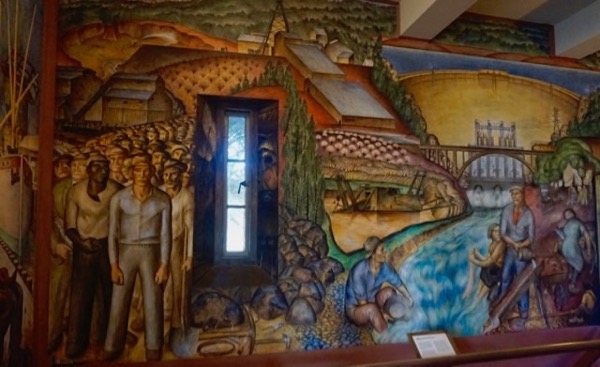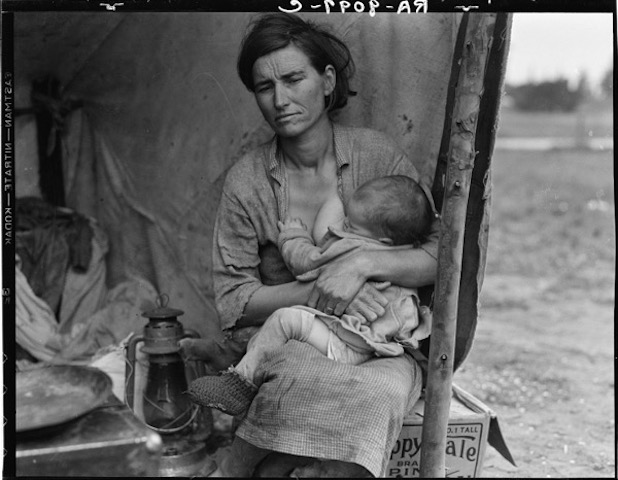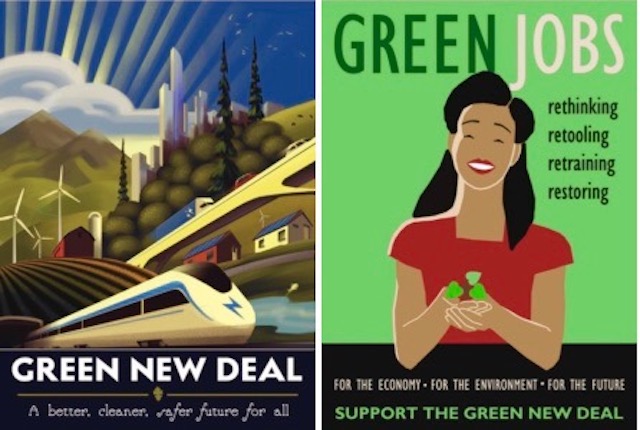NY Times Empties Iconic Depression Era Art of Political Content
History Helps Bernie!
The NYT has to lie.
Because an honest discussion of history, art and politics would put Bernie in the mainstream tradition of an FDR New Deal liberal Democrat, just while they are trying to paint him as a revolutionary totalitarian Communist amalgam of Stalin, Castro and Che.
[Updates below]
A New York Times feature on Depression Era photographer Dorothea Lange illustrates another important reason for supporting Bernie Sanders: his “Green New Deal” program could include restoration of the Federal Art Project (FAP) (see my 2009 post: Bring Back The Federal Art Project. Sadly, the news outlet NJ.Com deleted the photos from that post, which I try to reconstruct below.)
The significance of Depression Era art to the politics of the moment can not be over-stated. That era’s cultural, economic, and political history is instructive.
We are approaching depression era economic conditions; migrants, the homeless, poor people, workers, liberty, and government programs all are under attack; tent cities are exploding, especially in California; and the leading candidate for President – Bernie Sanders – is running based largely on revitalizing New Deal Programs, implicitly including the Federal Art Project.
So – especially in light of how the NY Times has attacked and even smeared Bernie Sanders – – including along cultural lines – how did the NY Times’ feature on Dorothea Lange engage these pregnant political issues?
They avoided and basically ignored them:
When I arrive in April 2019, Donald Trump has just visited Imperial County to stump for his wall. But I’m not here to talk politics, exactly. Instead, I’m on a pilgrimage to visit as many of the places Dorothea Lange photographed in California as I can.
That is a lie by omission.
But, the NYT has to lie.
Because an honest discussion of history, art and politics would put Bernie in the mainstream tradition of an FDR New Deal liberal Democrat, just while they are trying to paint him as a revolutionary totalitarian Communist amalgam of Stalin, Castro and Che.
But aside from politics, how did they address the sources of Ms. Lange’s work – including the financial sources?
Again, by basically ignoring the fact that Lange was a New Deal artist employed by a New Deal government agency (and they buried mention of that agency and provided no link to educate readers about the Farm Security Administration);
Ms. Lange, best known for her Depression-era photographs of migrant laborers, began photographing bread lines and labor strikes near her San Francisco studio in 1932….
As the Great Depression worsened, she began photographing people she saw on the streets: men curled up sleeping or in line for food. In 1935, she married the economist Paul Taylor; they left San Francisco together to photograph the living conditions of agricultural laborers up and down the state, from Davis and Marysville all the way to Imperial County. The Farm Security Administration supported their work.
Of course, the NY Times piece included the famous iconic photo of “Migrant Mother”.
But here’s another take – and it is even more beautiful and honest – on the classic Depression Era photo by Dorothea Lange:
Obviously, that photo was way too far ahead of its time to be published in 1935 –
Remarkably, today it would suffer exactly the same fate – censorship – given the political power of right wing Christians and the censorious and misogynistic Trump/Pence White House.
[Update – 3/8/20 – I just happened upon this essay, which provides important context of for the photo that I’d like to make a few points about. Here’s the author’s take:
Another photo shows her breastfeeding, revealing a white breast in contrast to her darker, sun-exposed skin. Thompson’s face reveals a kind of pleasure and almost peace in the activity — again, a picture that might have been rejected later for its lack of consonance with assumptions about the starkness and hardship of poverty. In terms of their interactions, the woman might have been asked by Lange to breastfeed the baby. The duration of the encounter — the supposed quick snaps leading to the iconic photograph — had to have been longer than 10 minutes, in order to allow the baby (who is sleeping in all the other pictures) to wake up and begin feeding.
First of all, again note – in this excerpt and throughout the essay (with the exception of one jab at “the left”) – how the analysis is emptied of any political meaning. The author’s essay discusses the photo almost exclusively in the context of its impact on this specific woman, concluding that it provided no benefits. That is misleading, because this photo did impact public opinion and government decisions. The workers camp at this site was later provided with food and other benefits (but these came after the woman and her children in the photo had left the camp).
In contrast, note how I immediately framed the context at the social and political level (as opposed to the individual and aesthetic) and directly linked it to misogyny, censorship, and religious power in the US and Trump administration. The author would be terrified to and never make that kind of blunt – but honest – assessment. Such is the courage of the good professor, who wrote narrowly and won he did widen the scope to the social, he only alluded to public opinions about the “starkness and hardship of poverty.” This is a surprising Neoliberal framework for a student of Edward Said.
Second, the author is a male. I am too. Knowing little of a woman’s experience (my X breastfed our kids) I found the scene beautiful and honest. I would never speculate about the woman’s actual feelings – but if I did, I certainly would not have audacity to presume and speculate that the photo “reveals a kind of pleasure and almost peace in the activity”. Is that a form of literary “mansplaining”? If anything, the expression on the woman’s face looks like either drudgery or that she’s a little pissed off at having had her privacy invaded by the photographer.
Third, does this author have children? Why would he think it takes more than 10 minutes for a child to awaken and begin nursing? I seem to recall our kids waking up hungry and going for the beast and being fed almost immediately! ~~~ end update]
But, Trump/Pence are not the only censors in town.
As we can tell from reading the NY Times narrative of the Lange photos, NYT writers and editors steer clear of any references to politics and history, especially those that would benefit Bernie Sanders!
George Biddle, the founder of the Federal Art Project (FAP) in 1935, said that because of the FAP, the Depression exerted, “a more invigorating effect on American art than any past event in the country’s history.” … For American art, it was a vital period that invigorated the entire country’s perception of what art could be and brought American art into the international forefront
The FAP created thousands of murals (scroll down for Coit Tower murals) in public buildings all across the country. Artist such as Jackson Pollock, Mark Rothko, Willem de Kooning, and Louise Nevelson, all left a moment of their creativity to posterity because of this program. As art historian Francis O’Connor said, “Something very vital indeed, something revolutionary happened to American culture during the 1930’s.”
One of the FAP’s major activities was the index of American Design. The project helped popularizing American folk art by documenting the countries “usable past” of over 20,000 photographic records of American art, painting, sculpture, handicraft and folk art.
By 1943, unemployment –the primary reason for the programs creation –dipped to the point that the program was canceled. The Library of Congress is the largest single holder of WPA posters, having over 900 in its collection.
[End Note: here’s a list of my favorite Federal Art Project photos that I included in that 2009 post. Unfortunately, the links don’t work, but if you word search the Library of Congress, they are easily found:
Matanuska Colonists : A couple with child
Wall Street
FBI and the Statue of Liberty
Farmer and Sons Walking in Face of Dust Storm
Country Store on a Sunday Afternoon
Eat more fish
Smiling Girls from Utuado
Commuters
Railroad Women Having Lunch
Itinerant Photographer, Columbus, Ohio
Children in the tenement district, Brockton, Mass.
black neighborhood, New Orleans
[Update: 3/1/20 – Pure coincidence: Announcement of this interesting Exhibition just hit my email: March 6 Canessa Gallery Exhibit – Art and Activism: From the New Deal to the Green New Deal – so glad to see this!!!!!



